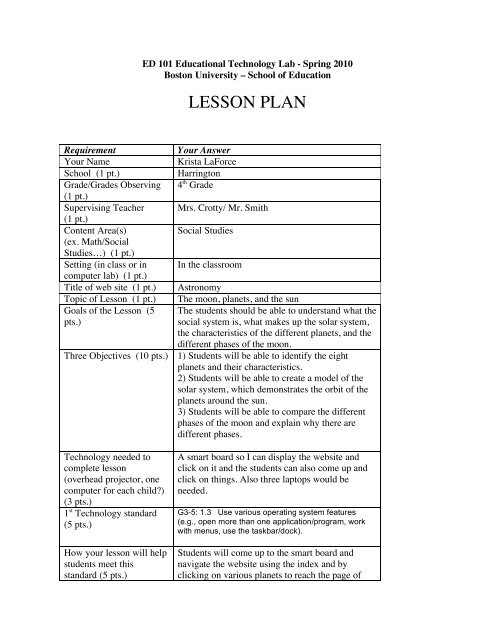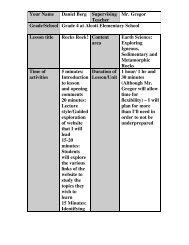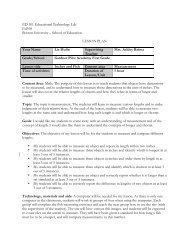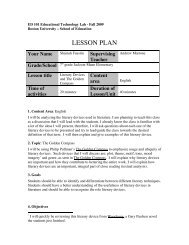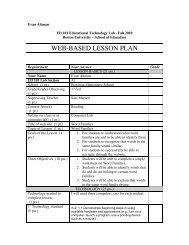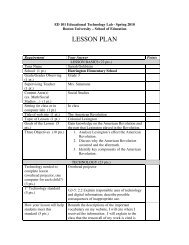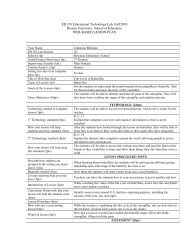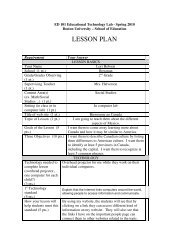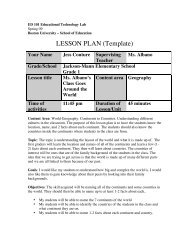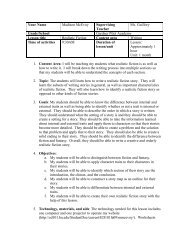Astronomy Lesson Plan.pdf - ED101 - Boston University
Astronomy Lesson Plan.pdf - ED101 - Boston University
Astronomy Lesson Plan.pdf - ED101 - Boston University
Create successful ePaper yourself
Turn your PDF publications into a flip-book with our unique Google optimized e-Paper software.
ED 101 Educational Technology Lab - Spring 2010<strong>Boston</strong> <strong>University</strong> – School of EducationLESSON PLANRequirementYour NameSchool (1 pt.)Grade/Grades Observing(1 pt.)Supervising Teacher(1 pt.)Content Area(s)(ex. Math/SocialStudies…) (1 pt.)Setting (in class or incomputer lab) (1 pt.)Title of web site (1 pt.)Topic of <strong>Lesson</strong> (1 pt.)Goals of the <strong>Lesson</strong> (5pts.)Your AnswerKrista LaForceHarrington4 th GradeMrs. Crotty/ Mr. SmithSocial StudiesIn the classroom<strong>Astronomy</strong>The moon, planets, and the sunThe students should be able to understand what thesocial system is, what makes up the solar system,the characteristics of the different planets, and thedifferent phases of the moon.Three Objectives (10 pts.) 1) Students will be able to identify the eightplanets and their characteristics.2) Students will be able to create a model of thesolar system, which demonstrates the orbit of theplanets around the sun.3) Students will be able to compare the differentphases of the moon and explain why there aredifferent phases.Technology needed tocomplete lesson(overhead projector, onecomputer for each child?)(3 pts.)1 st Technology standard(5 pts.)How your lesson will helpstudents meet thisstandard (5 pts.)A smart board so I can display the website andclick on it and the students can also come up andclick on things. Also three laptops would beneeded.G3-5: 1.3 Use various operating system features(e.g., open more than one application/program, workwith menus, use the taskbar/dock).Students will come up to the smart board andnavigate the website using the index and byclicking on various planets to reach the page of
2 nd Technology standard(5 pts.)How your lesson will helpmeet this standard (5 pts.)Describe how students aregrouped in the setting youlisted above (3 pts.)Materials needed(handouts, etc.) (2 pts.)List any teaching help youmay have (classroomteacher, parent, aide?)(2 pts.)Introduction of <strong>Lesson</strong>(3 pts.)Curriculum Frameworkthat your lesson will helpthe students meet (5 pts.)<strong>Lesson</strong> Procedure(save assessment detailsfor next section) (10 pts.)How web site is usedduring lesson (10 pts.)that planet.G3-5: 3.3 Evaluate Internet resources in terms of theirusefulness for research.Before reviewing my website I will review withthe students correct ways to get sources and wecan check some of the sources used in my websiteand I can explain to them why they are reputable.Students will all be facing the front of the roomand I will be talking. They will be in rows.I will give the students a handout with a list ofvocabulary words, such as orbit and revolution,and it will also have key concepts on it, like phasesof the moon and all the different planets. Studentswill fill out the worksheet in groups after I teachthem about the solar system. Then they will usethe website to check their answers.An aide can assist me in helping the students fillout their worksheet.I will have a model of the solar system and explainto the students what it is. I will find out theprevious knowledge that the students have aboutthe solar system by asking them questions aboutwhat they already know.Recognize that the earth is part of a system called the“solar system” that includes the sun (a star), planets,and many moons. The earth is the third planet from thesun in our solar system.After I explain to the students the concept of thesolar system and how the planets revolve aroundthe sun, I would have them break off into threegroups. One group would use a laptop to researchthe sun, one group would research the moon, andthe other group would research basics about theplanets. Then we would come together and reportback what we learned. The students would then fillout the worksheet I mentioned earlier, and then wewould use the website to review the concepts andterms. They would check their answers using thewebsite and correct them if need be.The website would be used as a way of reviewingand reinforcing the key concepts and terms. It alsowould give me the opportunity to explain how to
Wrap Up of <strong>Lesson</strong>(5 pts.)How will students beassessed? (10 pts.)How will you know ifstudents have met theobjectives stated above?(5 pts.)find valid sources online and it would give thestudents the opportunity to come up to the boardand navigate different pages and help me explorethe website.After we are done exploring the website, I willhave an informal discussion with the class wherethey would all tell me one thing that they hadlearned.I would ask the students to draw a picture of thesolar system and to label the planets for homeworkto make sure that everyone understands it. If Ineed to go over it again the next day, I will. Also Imight ask them to write for five minutes after thelesson about anything that has to do with the solarsystem to make sure that they understand the keypoints.If the students are able to draw a diagram of thesolar system and write a little bit about eachplanet, then I know that they have met the first twoobjectives. I could give the students a quiz aboutthe phases of the moon in order to make sure thatthey understand them.Here are the Quiz Questions:1. Which <strong>Plan</strong>et is the Fourth <strong>Plan</strong>et From the Sun?-Neptune-Mars-Saturn2. Which of these is NOT a Phase of the Moon?- Full Moon-Quarter Moon- Semi Moon3. What do the <strong>Plan</strong>ets Orbit Around?-The Sun-The Moon-Each Other4. Which <strong>Plan</strong>et is the Largest in our Solar System?-Uranus-Venus-Jupiter


